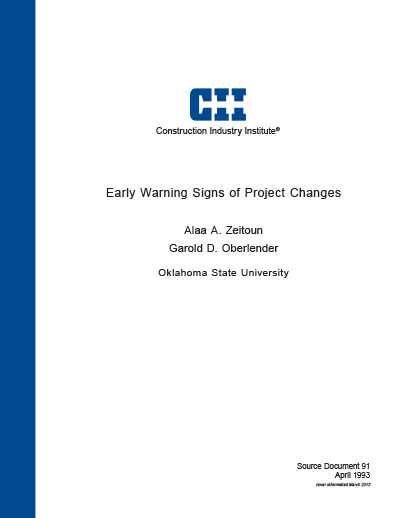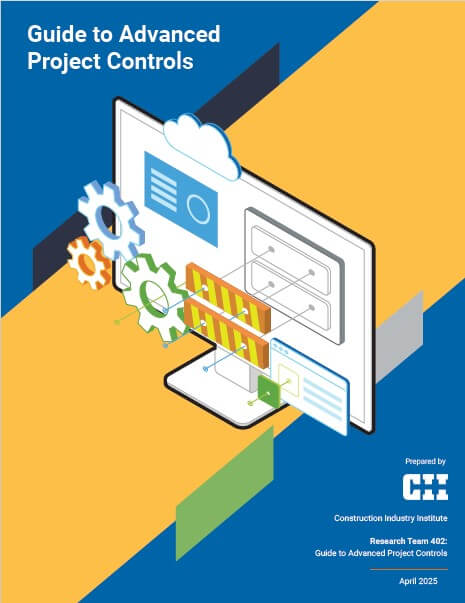
Early Warning Signs of Project Changes
In recent years, there has been a growing concern regarding the quantity and magnitude of changes which often cause excessive cost overruns, delays in time of completion, and reductions in the quality of the constructed facility. Most studies of project changes, or impacts of changes, have been directed toward dispute resolutions or craft productivity on a project. Little effort has been given to the study of multiple projects, to identify those factors that can be used to indicate potential changes in the original planned cost or schedule of a project.
In an effort to improve the cost effectiveness of the construction industry in the area of changes, the Construction Industry Institute (CII) formed a Change Order Impact Task Force in 1989 to study the impacts of changes in projects related to costs and schedules. This research study has been accomplished as a joint effort between the researchers of Oklahoma State University and members of the CII Change Order Impact Task Force team.
The intent of this research effort is to study multiple projects as a group at the macro level, rather than to study any one particular project at the micro level. The primary objective of this research was to identify factors which are known prior to the commencement of construction, which are early warning signs of project cost and schedule growth. It was not the intent of this research to develop a mathematical model for predicting the quantitative magnitude of cost and/or schedule growth of projects.
For this study, a questionnaire was developed to address a group of project data, cost data, and schedule data. The responses on the questionnaire provided a sample of projects from owners and contractors in the government and private sectors of the construction industry. A total of 106 projects were found usable from the 159 projects which were received from 23 companies. The total value of the original contract amounts reported was $3.9 billion. All of the received data were entered into a data base for the sorting and analysis that was used to develop the conclusions of this research. The total separation of fixed price and cost reimbursable projects was a key element in the analysis of this research data, due to the major differences in the contracting strategy of the two pricing formats.
This research has identified several early warning signs of cost and/or schedule growth during construction. For fixed price projects the early warning signs are in the categories of money left on the table, number of bidders, execution format, manner of bid solicitation, and owner type. For cost reimbursable projects the early warning signals are in the categories of primary driving factors, execution format, and work distribution. Professionals in the construction industry can use these signs to effectively manage project changes and control costs and schedules.
During this macro study of the factors indicating cost and schedule growth, a variety of topics for potential further investigation and evaluation were identified. These areas include micro study of each of the findings, the study of ripple effect, the improvement of the practices of the owner organizations as well as the construction companies, and the effect of the timing of the study.
{^widget|(widget_displayname)WatermarkImage|(name)WatermarkImage|(image)%7e%2fCII%2fmedia%2fPublications%2fSD91_Figure4-13.PNG%3fext%3d.png|(width)|(height)^}
{^widget|(image)%7e%2fCII%2fmedia%2fPublications%2fSD91_Figure5-6.PNG%3fext%3d.png|(name)WatermarkImage|(widget_displayname)WatermarkImage|(width)|(height)^}
{^widget|(widget_displayname)WatermarkImage|(name)WatermarkImage|(image)%7e%2fCII%2fmedia%2fPublications%2fSD91_Figure7-2.PNG%3fext%3d.png|(width)|(height)^}
(SD-91, p. 74)
The second brainstorming session covered aspects of both fixed price and cost reimbursable projects. Some of the recommendations included:
- Award the Construction Manager at the same time as Design Engineering to get the CM involved in early planning
- Develop a partnering approach between owner, engineer and CM
- Freeze the design input by involving the owner’s operating department in design reviews
- Implement one project control and reporting system for the project
- Divide the construction into specialty bid packages and have the CM coordinate communication and scheduling among the specialty contractors
- Provide incentives to the CM to keep the cost down
- Pre-qualify a larger number of bidders
- Do not always award to the low bidder and re-bid if necessary



